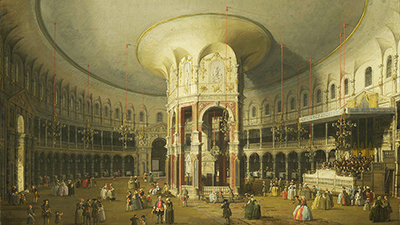London: Interior of the Rotunda at Ranelagh by Canaletto is a remarkable piece held by the National Gallery in London but not currently on display. The painting is an oil on canvas of dimensions 47 cm by 75.6 cm.
The painting, which focuses on the former Rotunda at Ranelagh Gardens in Chelsea was created in 1754 by Canaletto, a Venetian artist, and is an artchitecture painting of the genre Veduta. One of the significant things about this painting is that it depicts a building that only stood for 65 years at most, from the 1740s to 1805 an iconic and exclusive visitor attraction for the wealthier classes. Canaletto's picture was painted within years of the building being created, and the building was then demolished approximately 50 years later, so the painitng shows a magnificent building that no longer stands, and is one of the only images of the building. The painting has a wonderfully spacious and grand feel to it. Showing the full majesty of the Rotunda's interior. The foreground is greeny-grey and shows crowds of ladies, gentlemen and children, standing around and talking, socialising, while the children play.
To the side, people sit in an exclusive box. To the middle, the great architecture of the central stand and organ and sides where ladies and gentlemen are seated are in great detail, with the coloured walls and gold trimming standing out, while an entranceway shows up unobtrusively, bringing natural light into the building. Chandeliers hang on long cords from the ceiling. It is hard to see what the floor material is for the rotunda, but a wide paved path leads up to the central stand and organ, while the picture shows people sitting and standing round the steps to the stand. This is obviously before or after an event or even during the day, people are just milling around apart from a group of people in seating. The rotunda and gardens were upmarket and exclusive, hence the crowd in the painting being ladies and gentlemen rather than common folk, the charge to enter was at least two shillings, which wasn't a small amount in those days. The rotunda was used for concerts and events, hence the exclusive seating box and individual audience spaces around the sides.
The feature, in the top section of the picture, is the awe-inspiring circular sweep of the ceiling, with its remarkable wide space and gold banding. The central column reaches up to the ceiling in the centre, the golden decoration stands out, and the use of light and dark, the indication of light entering from somewhere other than the door in the centre, is a lovely finish.




